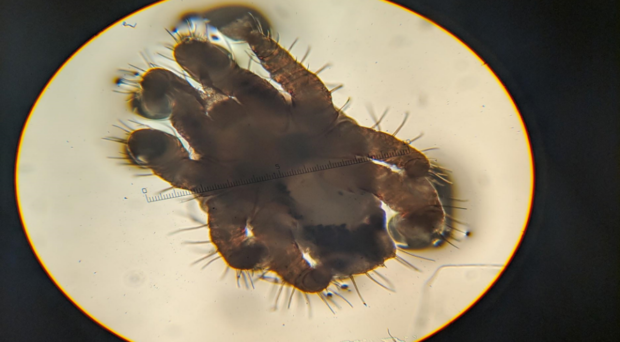
As we grow up, we learn facts and explanations from textbooks and teachers about the world around us. Most classroom activities in K-12 and even in undergraduate courses use canned labs to demonstrate a concept or a mechanism that have one right solution if done correctly. Published studies paint a clean, straight story from idea to conclusions, leaving out the many failed starts and frustrations along the way. Serving such a sterilized version of science makes the impression that science itself is a tome of absolute and certain knowledge, gained in a straightforward process, and that most of what is to know has already been discovered and explained.
Not surprisingly, this simplified perspective of science could not be further from the truth. While humanity certainly amassed an immense amount of knowledge, there are vast gaps in our understanding, especially when it comes to specific, local and less studied organisms. In addition, science is messy, and most things we try do not work as intended, especially in the first iteration. Projects morph over time, take on new objectives, and lead to potentially unexpected discoveries, as well as puzzling frustrations. This uncertainty is partly what makes being a scientist so much fun. It’s important for college graduates to appreciate these aspects of science, in order to become effective science consumers and advocates for science.
Every Spring quarter I teach a Senior Capstone class in Disease Ecology for undergraduate students at the Department of Biology at Eastern Washington University. The purpose of this class is to provide a culminating experience for graduating seniors, where they can integrate everything they learned throughout their college career. I have the additional purpose to instill an appreciation of the complexity of disease ecology, involving natural as well as social aspects, and their effect on ecosystem processes. Many students in the class are heading to health-related professions, and I’m happy if they’ll remember to go beyond a simple differential and ask for patient history when they practice medicine.
This particular class provides excellent examples of the messiness of science, and the large gaps in our understanding of the world around us. I give large leeway to my students in selecting their projects, with few constraints. This means that I’m not specifically knowledgeable on the background of their projects, which forces them to educate themselves. I get to learn about the organisms they study, which is fascinating. Many times, projects don’t turn out as they were planned. In this class, I put the emphasis on effort, since even if they don’t get the expected results, we still learn from that. This year’s class in particular provided good examples of the messiness of science, and unexpected results. I asked my students to summarize their projects, with particular emphasis on these aspects, please see them below! I’m sure many of you can relate to their experiences, either from classes you took, or even from your research in the lab (or field)! Please share those stories below in your comments. Enjoy!
Discovering ectoparasites on bats during a White Nose Syndrome survey in Eastern Washington
By Connor Abney, Aaron Hope and Jamie Olson

Bat populations in the United States have been rapidly decreasing since the presence of Pseudogymnoascus destructans, or more commonly called the White Nose Syndrome fungus, was first detected on the East Coast back in 2006. Over the past decade the disease has slowly been making its way across the country, with some cases popping up here on the West Coast. With the assistance of Washington State Fish and Wildlife (WSFW), we were able to go out to a location in Lincoln County, WA and conduct a field survey on a population of Myotis yumanensis (a species of vester bat), to 1) help WSFW find and identify, if any, White Nose Syndrome on the bats observed, and 2) to see if the presence of ectoparasites on the bats were promoting or hindering disease through increasing pathogen load of the microbiome.
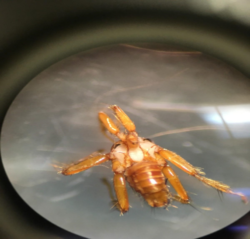
If any bats were found to have ectoparasites, they were removed and stored for later identification, and all bats observed had their microbiome sampled with dry swabs. Two types of ectoparasites were observed. The first is a type of bat mite belonging to the order Mesostigmata (black). The other is more unique, as it belongs to the genus Basilia, and though is classified as a “Bat Fly” it lacks any wings and only has halters in place of where the wings were lost in evolutionary time (orange). Samples collected underwent PCR and ran through a gel electrophoresis to test for quality and purity of DNA. Samples were then sent to an outside lab for testing. Unfortunately, the first round of testing yielded very low quality DNA, to the point the data was unusable. While waiting for further results, we decided to compare ectoparasite presence versus sex and weight of the bat since this is the only usable data we have at this point in time. A strong trend was seen for ectoparasites favoring males over females, (p=0.059), though this was not statistically significant. There was also a trend towards bats that had ectoparasites to be heavier that those without them. Luckily, no White Nose Syndrome was detected in the bats tested.
Variables affecting the prevalence of Bartonella spp. colonization of cats in Spokane County, Washington
by Tina Cao, Samantha Cheever, Aleesha Grove, Halli McGraw, Jenny Peterson, Kevin Scott, and Laura Tarango
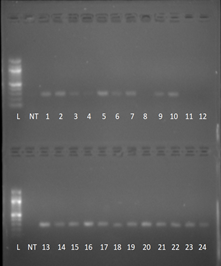
Zoonotic infections are transmitted from an animal host to a human host. Our common house pets are reservoirs for numerous zoonotic infectious diseases. A common one is a genus of bacteria called Bartonella which can lead to Cat Scratch Disease (CSD) in humans. CSD is transmitted from an asymptomatic cat through a scratch or bite that breaks the surface of the skin. This contamination with their saliva transmits the bacteria to our blood stream. Since nearly 40% of cats carry this bacteria in general, it’s surprising that we don’t see a lot of cases of CSD. While it has a high impact on those of a suppressed immune state, the recently sick, children or elderly, a normally functioning immune system can defend against the bacteria without a problem. This study aimed to determine the prevalence of Bartonella spp. in cats of Spokane County, which we had no information about before. About 87% of the cats sampled tested positive for Bartonella spp. which is high but not unheard of. Within our sample we saw an increase in the prevalence of Bartonella spp. in younger cats from an animal shelter weighing eight pounds or less. Sequencing will soon be conducted to determine if the Bartonella species found are Bartonella henselae or another less infectious strain of Bartonella. If you have a cat in or from Spokane county, ensure all scratches and bites are washed thoroughly and observed for any signs of infection!
Induced Inflammatory Bowel Disease and Lactobacillus acidophilus in Mice Model
by Ryan Cao, Hailey Gieser, Lindsey Gieser, Christina Hill, Chandler Hodge, Hayden Jones

In 2004, inflammatory bowel disease (IBD) affected nearly 1.4 million people in the United States alone. The disease is characterized by an imbalance of the normal gut microbial flora. Dextran sodium sulfate (DSS) is widely used for inducing epithelial damage. It is believed to have a barrier dysfunction mechanism that allows for bacteria to have easier entry into the host. The most promising probiotic seen so far to treat IBD are different species of Lactobacillus. Our research focused on determining if L. acidophilus can be used as a probiotic to reduce weight loss associated with inflammatory bowel disease in mice. We hypothesized that mice that received the L. acidophilus supplement after treatment with DSS would lose less weight than mice that do not receive the L. acidophilus supplement. The experiment was split into 3 groups. Group one was given L. acidophilus orally daily for three days and then was given 3% dextran sodium sulfate salt (DSS) in the water to induce IBD. Group two was only given 3% DSS water in their normal water bottles to induce IBD, but no L. acidophilus supplement. Group three has received neither DSS nor the probiotic supplement. Weights of all the mice were taken every day for ten days to track their progression. If any mouse had lost 20% of their initial weight, they were euthanized for humane treatment. Our goal of this project was to understand the effects of probiotics on IBD to reduce symptoms, but our results were inconclusive. Our mice did not have any significant weight loss at all and thus could not conclude if L. acidophilus effected the weight loss of IBD. We think the weight loss did not occur in the mice was because of an inconsistent amount of DSS water that each mouse was consuming. If the experiment was redone with a consistent amount of DSS water given to them daily, then we think this mouse model would be very successful to see if L. acidophilus effects the weight loss of IBD.
Feeding and oviposition preference of adult mosquitoes collected at Turnbull National Wildlife Refuge, while trying to colonize them
By Donna Ganbaatar, Erika Magana, Joseph Moua, Savang Moua, Toby Moua
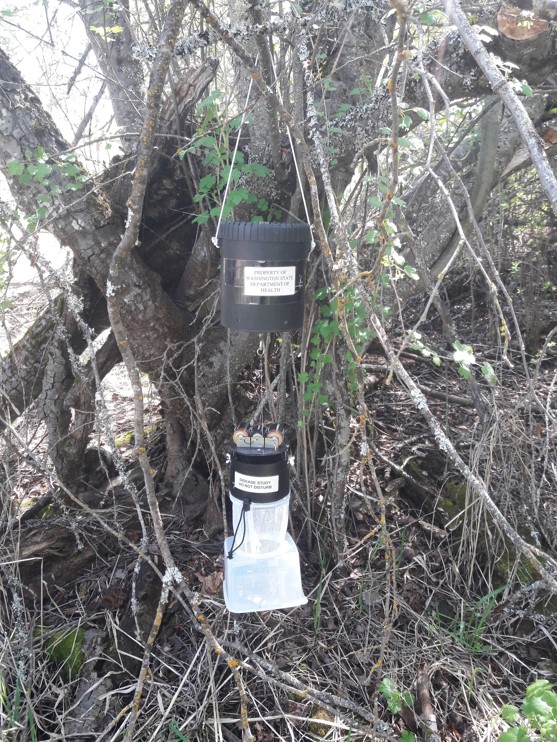
Mosquitoes are one of the most common vectors world-wide, responsible for the vast majority of cases involving human emerging diseases. Although much of their biology, feeding mechanisms, host-pathogen interactions, and host preferences has been studied, our group set out to establish a mosquito colony for further study within our area. Adult mosquitoes were collected from Turnbull National Wildlife Refuge (TNWR) using mosquito traps with dry ice. Larvae and pupae were collected from the Palouse Prairie restoration site at Eastern Washington University by fellow peers. Due to high mortality rates, a small number emerged successfully. Adult mosquitoes captured in early phases of the project were used for identification. A large percentage (94%) were of the genus Aedes with the addition of some Anopheles (5%) and Culex (1%). To mimic natural conditions, adult mosquitoes were transferred into a collapsible cage, exposed to 12-hour light and 12-hour darkness using an LED lamp attached to a timer. A wet towel was used to cover the cage in order to maintain high levels of humidity. The cage was enclosed in a cardboard box to eliminate natural light from affecting the light and dark phases from the lamp. Within our research project, we conducted two studies. First, we investigated the feeding site that the mosquitoes occupied most frequently within a 3-day trial with each trial consisting of a 30 minute feeding session. Feeding sites consisted of cotton pads soaked in 6 ml of 5% sucrose solution, a second solution made with a mixture of 3 ml of 5% sucrose and 3 ml of defibrinated sheep blood, and a third solution of 3 ml 5% sucrose and 3 ml of defibrinated human blood. Our data indicated that there was no significance between all three sites concluding that the mosquitoes were “not picky” feeders in our lab setting. Our second investigation focused on the preference in oviposition sites using a black plastic bowl and a white plastic bowl filled with 100 ml of distilled water and germination paper lined in the walls of the bowls. Unfortunately, due to the difficulty in trying to imitate natural climate conditions, no egg deposits were found throughout the lifespan of the mosquitoes. Because we were unsuccessful at the reproduction stage, establishing a colony was not achieved although mosquitoes were kept alive for approximately one month. Many mosquito colonies have been established all over the world in laboratory conditions using more efficient feeding methods and natural habitat simulations which we strongly encourage future student researchers to use.
Testing the efficacy of household liquids as Dermacentor tick repellents
by Hunter Lee, Jacob Ott, Nicholas Vanderholm
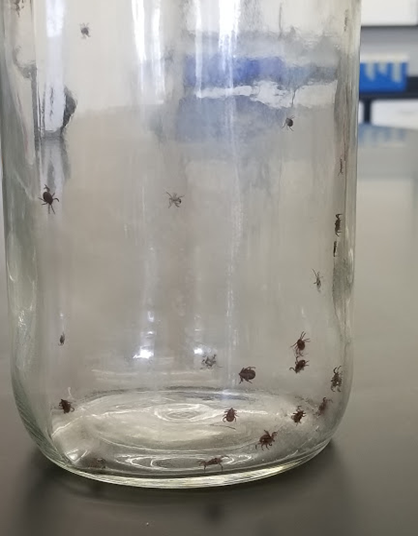
Here’s the scenario: your friend calls you up and asks if you would like to go on a hike this afternoon. You love to hike so you emphatically reply that you are in! However, your friend discloses to you that there is a catch…you will be going on a hike on a trail known to have a large population of ticks. You don’t have any tick repellent around your house but you don’t want to miss out on a good hike, so what should you do? We attempted to provide an answer to this question by testing the efficacy of household liquids as a substitute to commercially produced tick repellents on Dermacentor ticks collected at Turnbull National Wildlife Refuge. After preliminary trials, we determined that Febreeze and vinegar were the most likely to produce significant results over other various household liquids we tested, which ranged from garlic juice to used motor oil. Both liquids then moved on to research trials, where we tested their effectiveness as tick repellents against DEET and a control group with no repellent. To do this, we placed 10 ticks in a mason jar for 3 minutes and counted how many ticks were able to escape the jar. We applied treatments by soaking a cotton swab in the experimental liquid, and swabbed the liquid around the mouth of the jar. Ticks naturally crawl upwards and out of the jar, so ticks not escaping the jar would indicate that the liquid swabbed around the mouth of the jar was an effective tick repellent. We found that DEET was the only treatment group with significant results compared to the control group (p=0.043), and no ticks escaped the DEET jar in any of our trials. Febreeze appeared to be potentially effective since it had a lower average number of ticks escape the jar than the control group, but statistical analysis by way of a Fisher’s exact test showed no significance. Meanwhile, vinegar was not effective at all as it had a higher average number of ticks escape the jar than the control group, although the data was again not statistically significant. So in conclusion, what should you do if you are without tick repellent and your friend asks you to go on a hike? First of all, do not lather yourself in vinegar. You can however use Febreeze, and it may potentially have an effect. But don’t count on it being an effective tick repellent substitute. Instead you should try to get your friend to stop by a store and pick up a bottle of DEET tick repellent, and as always, you should wear long pants and long sleeves to cover as much skin as possible before heading out in the field.

Comments